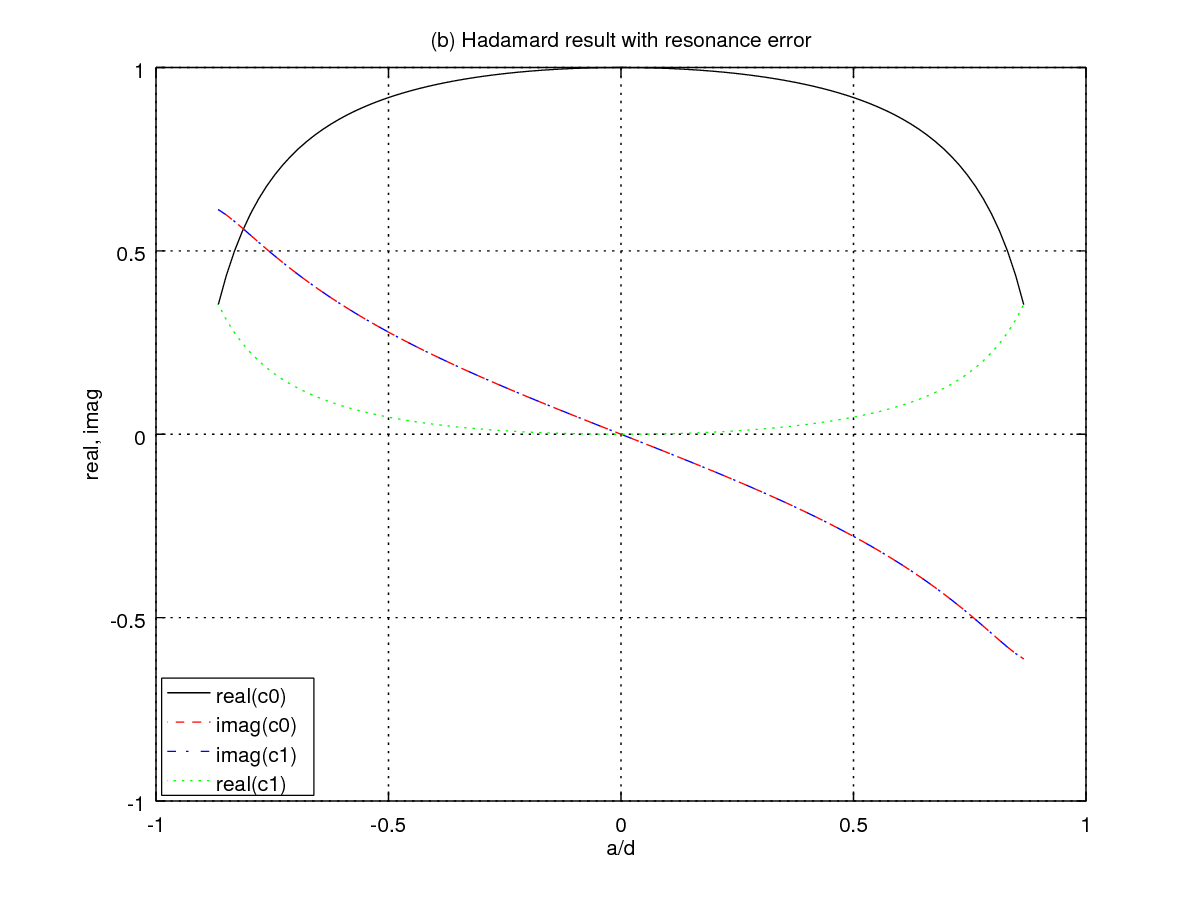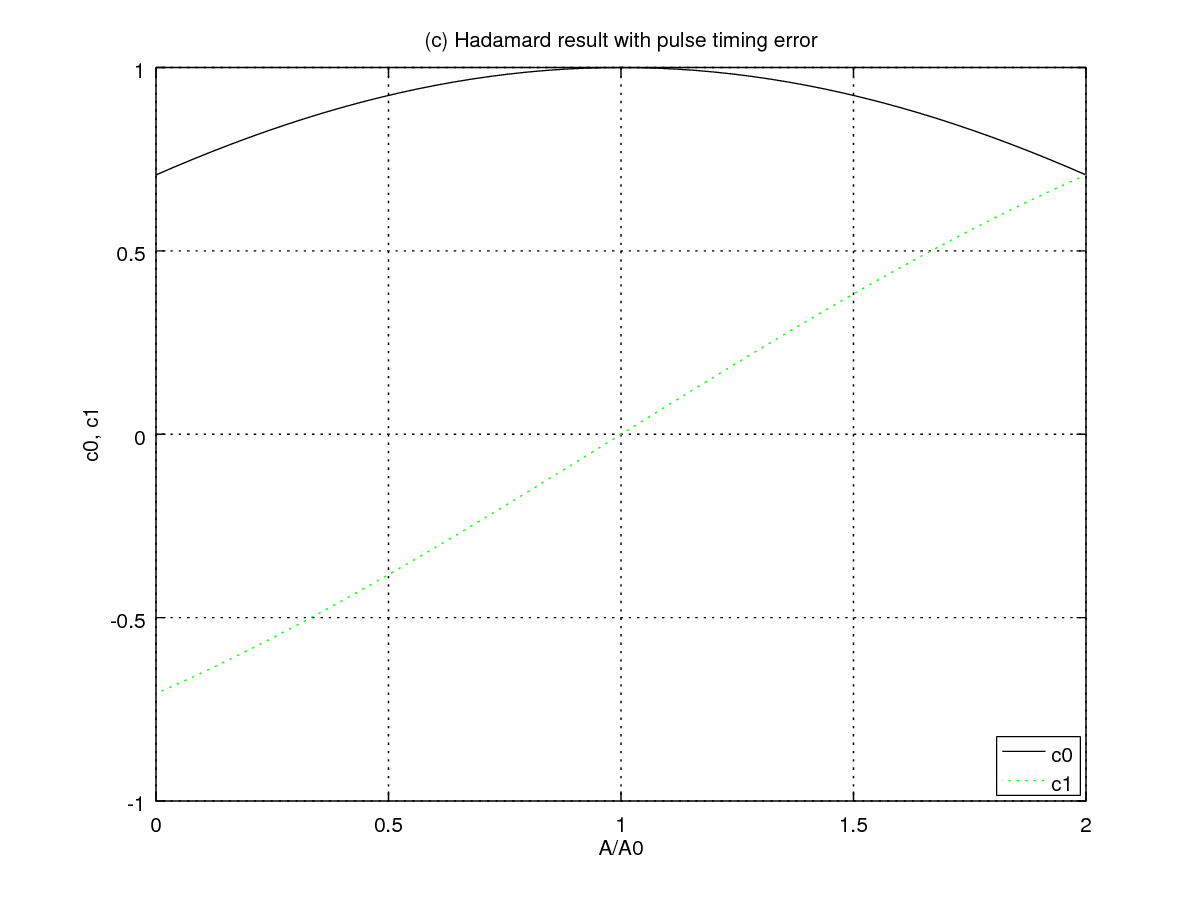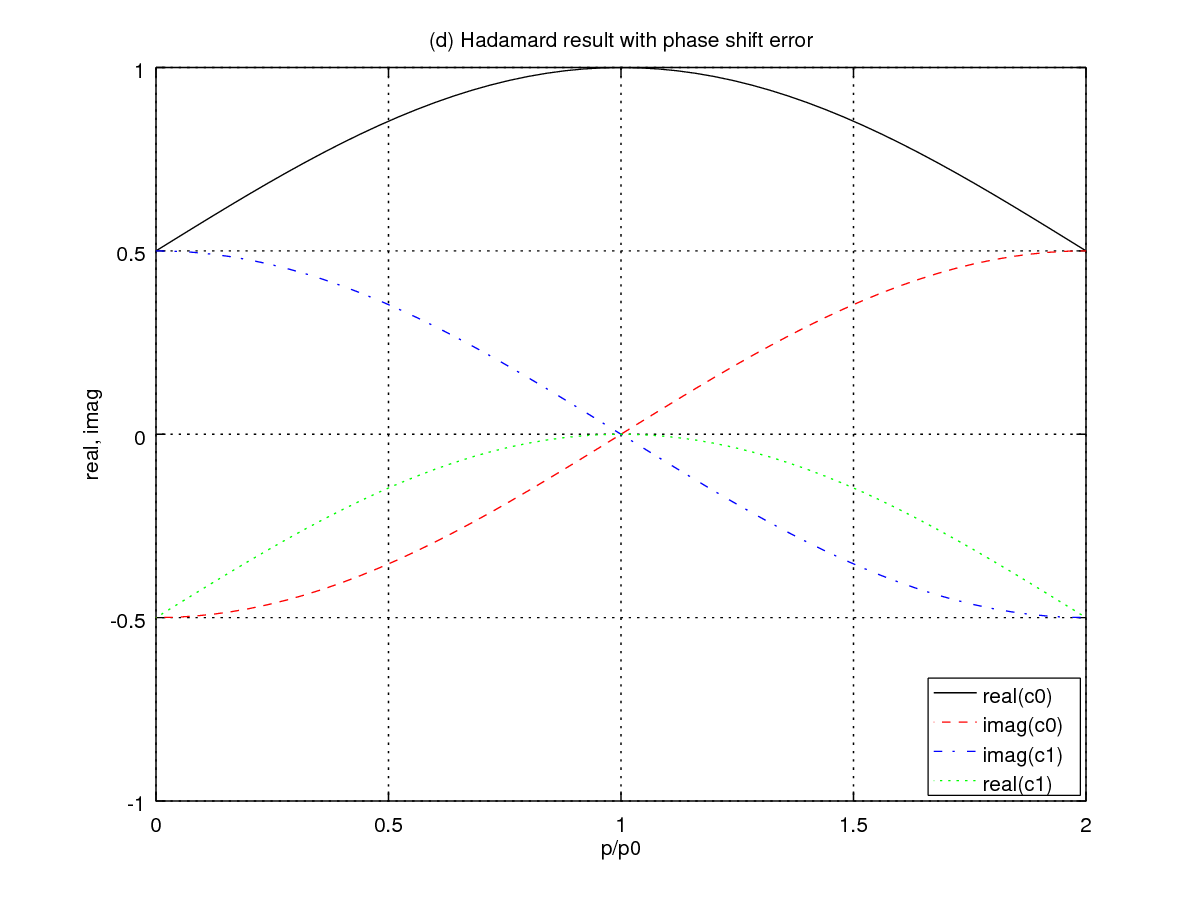
ω=ω0)
with phase shift φ
is derived in chapters 12 and 13 of [1]:
![]()
![]()

Here we assume that ω is not necessarily equal to ω0,
and we derive the formulas:
c0(t) = c0(0)(cos(dt)-(ia/d)sin(dt)) + mc1(0)(ib/d)eipsin(dt) c1(t) = mc1(0)(cos(dt)+(ia/d)sin(dt)) + c0(0)(ib/d)e-ipsin(dt)
where p=φ, a=(ω-ω0)/2,
b=Ω/2, and d=sqrt(a2+b2).
The multiplier m of c1(0) is m=1 for a simple π-pulse,
and m=-1 for pulses implementing the Hadamard transformation
(called Aj transformation in [1]).
The derivation is shown below after the analysis results.
Results
In each of the plots shown, the midpoint of the horizontal axis corresponds to no error, so points to the left and right of center represent the effects of negative and positive errors respectively.
 |
 |
 |
 |
c0(t1) and c1(t1)
for a non-resonant π-pulse (m=1,p=0)
applied until time t1=π/Ω=π/(2b):
c0(t1) = c0(0)(cos(A)-irasin(A)) + c1(0)(irbsin(A)) ==>> cos(A)-irasin(A) c1(t1) = c1(0)(cos(A)+irasin(A)) + c0(0)(irbsin(A)) ==>> irbsin(A)
ra=a/d, rb=b/d,
and A=π/(2rb).
The initial conditions are c0(0)=1,c1(0)=0,
and with no error we should have c0=0,c1=i
at time t1.
Figures (b,c) show results for a Hadamard transformation (m=-1,p=π/2):
c0(t) = c0(0)( cos(A)-irasin(A)) + c1(0)(rbsin(A)) c1(t) = c1(0)(-cos(A)-irasin(A)) + c0(0)(rbsin(A))
c0(0)=c1(0)=1/sqrt(2)
and no error (A=π/4) we should have
c0=1,c1=0 at the end of the pulse.
For Figure (b) the non-resonant pulse is applied until
time t2=π/(2Ω)=π/(4b):
c0(t2) = ( cos(A)-irasin(A)+rbsin(A))/sqrt(2) c1(t2) = (-cos(A)-irasin(A)+rbsin(A))/sqrt(2)
A=π/(4rb).
For Figure (c) the pulse is resonant (a=0,b=d) and applied until time t,
but there is a timing error:
c0(t) = ( cos(A)+sin(A))/sqrt(2) c1(t) = (-cos(A)+sin(A))/sqrt(2)
A=A0=dt=π/4.
For Figure (d) the pulse is resonant and applied for the correct time, but there is a phase shift error:
c0(t2) = c0(0)cos(A) - c1(0)ieipsin(A) ==>> (sin(p)+1-i*cos(p))/2 c1(t2) = -c1(0)cos(A) + c0(0)ie-ipsin(A) ==>> (sin(p)-1+i*cos(p))/2
p=p0=π/2
Derivation
The Hamiltonian for the proton spin in a uniform magnetic field is given in [1]:
![]()

Including the phase shift φ the last term becomes [1]:

Letting Ψ(t) = g0|0> + g1|1>
and substituting into the Schrödinger equation (12.1) we obtain:
i ∂g0/∂t = -(ω0 g0 + Ω g1 ei(wt+φ))/2 i ∂g1/∂t = -(-ω0 g1 + Ω g0 e-i(wt+φ))/2
g0 = c0 eiωt/2, ∂g0/∂t = (∂c0/∂t) eiωt/2 + (iω/2) c0 eiωt/2 g1 = c1 e-iωt/2, ∂g1/∂t = (∂c1/∂t) e-iωt/2 - (iω/2) c1 e-iωt/2
i ∂c0/∂t = c0 (ω-ω0)/2 - c1 (Ω/2) eiφ i ∂c1/∂t = -c1 (ω-ω0)/2 - c0 (Ω/2) e-iφ
Letting a=(ω-ω0)/2 and
b=Ω/2, and writing in matrix form:
|
= |
|
|
= A c |
c(t) = eAt c(0) = V eΛt V-1 c(0)
eΛt=diag(eidt,e-idt),
the eigenvalues of A are ±id,
d=sqrt(a2+b2),
and the columns of V are the eigenvectors:
V = |
|
Substituting and simplifying we obtain:
c(t) = |
|
|
[1] Introduction to Quantum Computers, Gennady P Berman, Gary D Doolen, Ronnie Mainieri, Vladimir I Tsifrinovich, World Scientific, 1998.